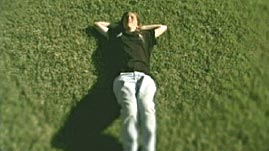Teachers' Domain - Digital Media for the Classroom and Professional Development
User: Preview


Source: ZOOM
(knocking)(hinge squeaks)
KATY HOAGLAND: Did you ever wonder if there's life on other planets? How the galaxies formed? Or if a human will ever walk on Pluto? Hi, my name is Katy Hoagland. I'm 12 years old and I live in Sherman Oaks, California. When I grow up, I want to be an astrophysicist, which is a person who studies the stars and planets spinning through space. There are countless objects to study in the sky.
I agree with many astronomers who think that there are more stars in our universe than there are grains of sand on this beach, possibly more stars than there are grains of sand on every beach in the entire world. But most of the objects in space are too far away to see very well your naked eye. That's why you need a telescope.
This is my telescope. I built it myself. It magnifies faraway objects and makes them appear bigger, like the Moon. My telescope took me 30 hours to build. It's mostly made of ordinary materials. The design is so simple that anyone can build it. It's lightweight and I can move it around myself.
The tube is made of cardboard. (knocks) (knocking) The base is plywood. This shower cap works as a dust cover to keep the dust off the mirror. It's a ten-inch reflecting telescope and this is how it works. Light from stars and planets enters the top of the telescope and is collected at the bottom of the tube by a ten-inch curved mirror.
The light then bounces off the ten-inch mirror back up the tube to the second smaller mirror here. The light is then reflected into the eyepiece, which magnifies, or enlarges, the image.
The hardest part is grinding the glass for the mirror. It takes about ten hours. After we're done with that, we take it to an aluminizer, who makes it more like a mirror. This is the finished product, a ten-inch reflector.
Is there life out there? Can we colonize other planets? We don't know the answers to all of these questions yet, so for now, I'll just keep on stargazing. Hey, maybe there's another kid with a telescope at the other end of the Milky Way looking out at me.
 Loading Standards
Loading Standards Teachers' Domain is proud to be a Pathways portal to the National Science Digital Library.
Teachers' Domain is proud to be a Pathways portal to the National Science Digital Library.
